With their imposing stature, piercing gaze, and rugged attractiveness, it’s easy to see why the Rottweiler captivates the imagination. This powerful working breed originates from Germany, where they drove cattle to market and guarded valuables with fierce devotion. While their roots are rugged, Rottweilers ultimately yearn to serve and protect their human companions.
Delve deeper into the origins, characteristics, care, and considerations for owning this multipurpose breed. Discover why the Rottweiler’s intelligence, versatility, and loyalty have earned them a special place in homes and hearts across the globe.
Table of Contents
- 1 History and Origins: Born to Work and Serve Mankind
- 2 Personality and Temperament: Confident, Courageous, Devoted
- 3 Physical Characteristics: An Impressive Fusion of Strength and Agility
- 4 Grooming and Care: Low Maintenance with Notable Requirements
- 5 Training and Socialization: Cultivating an Upstanding Canine Citizen
- 6 Home Life and Family: Finding the Right Setting
- 7 Serving Humankind: Rottweilers as Service and Working Dogs
- 8 Potential Health Issues: Staying Informed and Proactive
- 9 Finding a Rottweiler: Choosing a Reputable Source
- 10 The Rottweiler: A Dog for Distinguished Owners
- 11 Related posts:
- 12 The Truth About Rottweiler Aggression: Debunking Myths and Promoting Responsible Ownership
- 13 Rottweilers Running
- 14 Are Rottweilers good for jogging?
- 15 How Fast Can A Rottweiler Run?
History and Origins: Born to Work and Serve Mankind
The Rottweiler derives its name from the small town of Rottweil in the southwest German state of Baden-Württemberg. Dating back to the Roman Empire era, Rottweil hosted large cattle markets where the early ancestors of today’s Rottweiler were utilized to herd livestock.
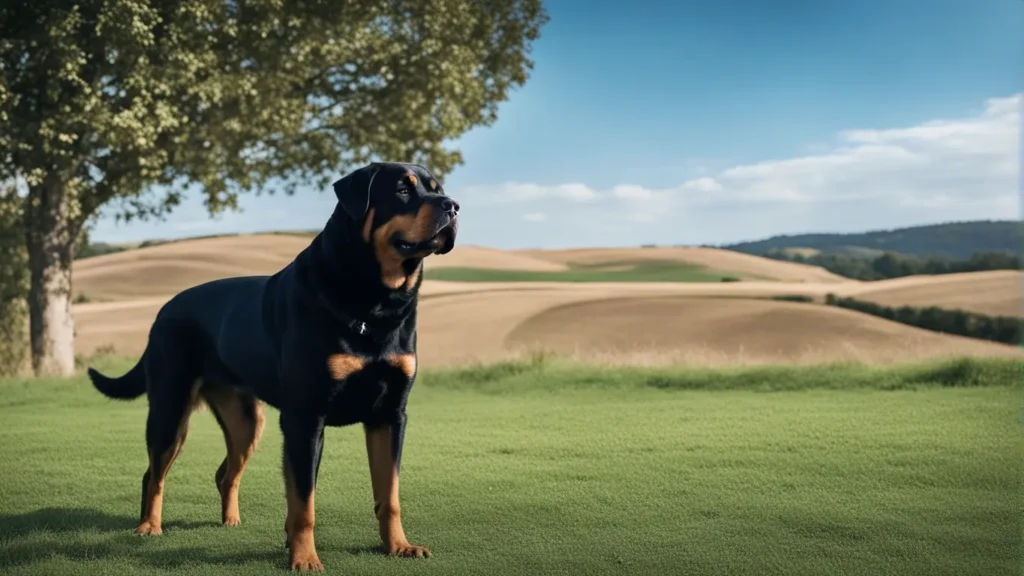
These brave dogs, Drover Dogs, drove cattle over long distances to the markets. They also carried money pouches tied around their necks to pay for the livestock upon arrival. The dogs’ innate protective instinct ensured the money’s safe transport.
By the late 19th century, cattle driving was replaced by the advent of the railways. Rottweiler numbers dwindled as their role diminished. Fortunately, they had already garnered recognition for their reliability, intelligence, and protectiveness. This enabled the breed to transition into police and guard dog roles to carry on their working legacy.
During World Wars I and II, Rottweilers served as messengers, ambulances, draughts, and guard dogs in the military. Their courage, obedience, and versatility solidified them as vital contributors. Police and security forces today continue to count on Rottweilers, who use their exceptional scent-tracking ability to locate missing persons, fugitives, and illegal contraband.
Beyond their working roles, Rottweilers began gaining popularity as household companions and show dogs by the early 1900s. Companion events were held as early as 1901 in Germany, with the first Rottweiler club forming in 1907. The breed gained American Kennel Club recognition in 1931 and today ranks as the club’s 9th most popular dog breed.

Personality and Temperament: Confident, Courageous, Devoted
The Rottweiler possesses a self-assured, fearless temperament befitting its guarding and police lineage. This calm yet authoritative breed takes its role as a protector seriously. Owners describe them as observant and constantly aware of their surroundings. With family, Rottweilers display deep devotion. They crave affection and seek close human bonds. This combination makes them at once a stalwart defender and an affectionate companion.
Strong-willed and purposeful, Rottweilers respond exceptionally well to firm, consistent training. Their high intelligence enables them to absorb commands rapidly. However, their independent thinking necessitates an experienced trainer who can provide clear direction and boundaries. Proper socialization from puppyhood is critical to curb overprotectiveness and aggression toward strangers or other animals. Well-socialized Rottweilers display a wait-and-see attitude with strangers instead of hostility. They get along well with other pets when properly introduced.
The ideal Rottweiler owner is prepared to provide ample stimulation, exercise, and training for this active, muscular breed. Rottweilers make for imposing but peaceful guardians and steadfast family protectors in the right hands. Their devotion and desire to serve is unparalleled.

Physical Characteristics: An Impressive Fusion of Strength and Agility
One look at the Rottweiler reveals a substantial breed exuding rugged power and athleticism. Males stand 61-69 cm (24-27 inches) tall at the shoulder, and females 56–63 cm (22-25 inches). On average, males weigh 50-60 kg (110-135 lbs), and females weigh 35-48 kg (80-105 lbs).
The Rottweiler’s broad head features a wide, deep muzzle, pronounced cheek muscles, and medium-sized, almond-shaped eyes conveying an alert, intelligent expression. Triangular ears stand erect. The breed sports a thick double coat with an outer layer of straight, coarse black hair and an undercoat to insulate in cold weather. Rich mahogany markings above the eyes, cheeks, muzzle, chest, and legs contrast beautifully against the jet-black coat. The rear legs have feathering. The Rottweiler’s long tail is customarily docked.

This substantial yet agile breed boasts free-flowing, economical movement, allowing it to maneuver its large size easily. No-frills grooming and low-maintenance care make them ideally suited for work. Their physical prowess will enable them to keep pace with an active family or handler.
Grooming and Care: Low Maintenance with Notable Requirements
The Rottweiler’s short coat requires minimal grooming to look sharp. Use a rubber curry brush or grooming glove once weekly to remove loose hair and distribute coat oils. Bathe only when necessary using a dog-specific shampoo. Rinsing thoroughly prevents skin irritation.
Other grooming needs include trimming nails as needed, typically every two weeks. Inspect ears weekly and clean inside folds gently but thoroughly with a veterinarian-approved cotton balls cleanser. Monitor for signs of infection, including redness, swelling, or odor. Brush teeth twice or thrice weekly with soft toothbrushes and dog toothpaste to prevent periodontal disease.
While their exercise needs can be met with daily walks and playtime, Rottweilers thrive on vigorous activity to maintain their impressive physique. Swimming, hiking, running beside a bike, or challenging games like fetch provide healthy physical and mental stimulation. Puzzles, obedience, or agility training also supply necessary mental enrichment.

Proper diet and nutrition are essential for this large, muscular breed. Feed high-quality commercial dog food appropriate for their age and avoid overfeeding. Keep clean, fresh water available at all times. Annual veterinary checkups plus preventatives like flea, tick, and heartworm medication promote lifelong health.
Training and Socialization: Cultivating an Upstanding Canine Citizen
Consistent training and extensive socialization starting in early puppyhood are paramount for raising a well-adjusted Rottweiler. Seek professional guidance from a qualified trainer, especially for first-time Rottweiler owners.
Rottweilers excel at obedience work thanks to their high intellect and eagerness to please their handler. Positive reinforcement techniques such as food rewards, praise, and play motivate them to learn commands and tasks quickly. Start with basics like sit, stay, down, come, heel, and leave it before moving on to advanced skills.
Equally important is socializing your Rottweiler thoroughly with various people, places, animals, and situations during puppyhood. Introduce them to children, strangers, loud noises, car rides, and more to prevent overprotectiveness or fearfulness later on. Seek puppy socialization classes to provide a controlled setting for positive experiences.
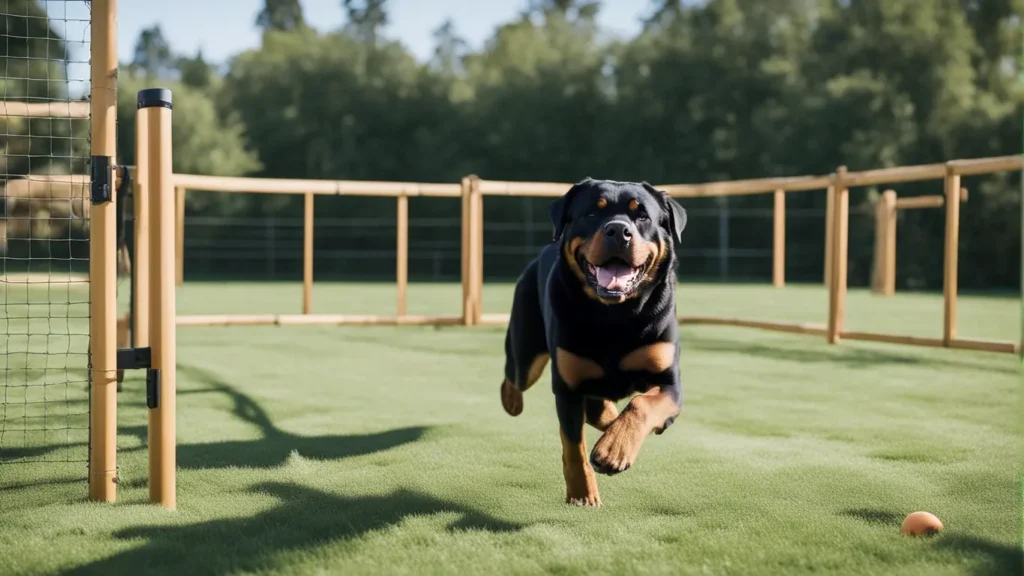
A well-trained, socialized Rottweiler is a pleasure to handle and a welcome community member. An untrained Rottweiler with inadequate social skills can present risks to themselves and others. Investing in their early development pays back exponentially over their lifespan.
Home Life and Family: Finding the Right Setting
Rottweilers require adequate space to move comfortably. A small house or yard works well, but apartments may feel confining unless the dog receives ample daily exercise. Access to a securely fenced yard provides a safe outlet for play and energy release. Underground electronic fencing is not sufficient to contain a Rottweiler.
Rottweilers can thrive in households with older, respectful children. Parents should always supervise interactions, especially with younger kids. With proper introductions and training, Rottweilers generally coexist peacefully with other pets. Breeders caution that same-sex aggression can occur, so choose your dog’s housemates wisely.
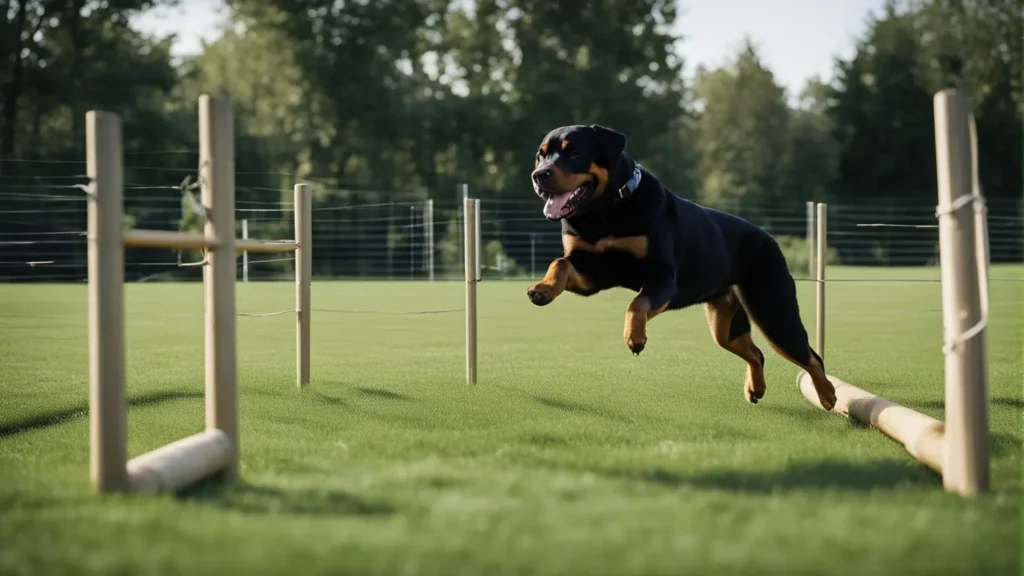
This people-oriented breed should never be left alone for long periods. Their protective nature makes them more alert in the absence of their humans and prone to nuisance barking. Providing companionship, activity, and training prevents boredom and problem behaviors.
Serving Humankind: Rottweilers as Service and Working Dogs
Beyond the family home, Rottweilers dedicate themselves to various meaningful work assisting humankind. Their intelligence, trainability, protectiveness, and work ethic suit them for specific roles.
Service Dogs
Some Rottweilers are bred and trained for service dog roles to support and assist individuals with disabilities. Tasks they can perform include:
- Guiding the blind or visually impaired
- Alerting the deaf
- Pulling wheelchairs or providing brace support
- Alerting to impending seizures or medical issues
- Retrieving medication, phones, or household items
- Providing stability and anxiety relief
Rottweilers selected as service dog candidates undergo meticulous training starting as puppies. Only dogs with sound temperament, health, and behavior meet service dog requirements. Partnering with accredited service dog organizations ensures proper breeding, raising, training, and matching practices are followed.
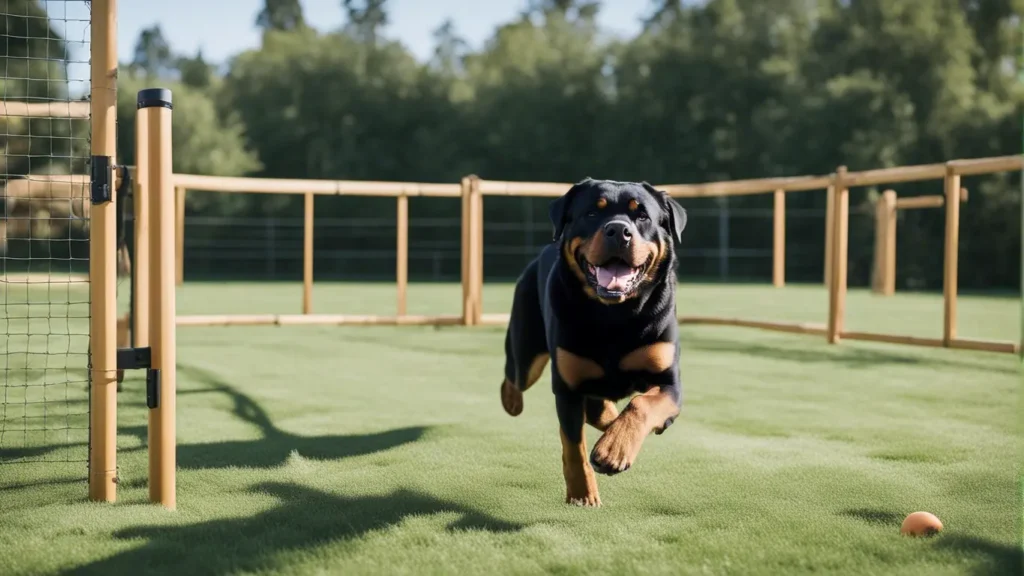
Police and Working Dogs
The Rottweiler’s origin as a cattle herding dog established key traits like intelligence, fearlessness, strength, and obedience that lend themselves well to police work. Many law enforcement agencies today employ Rottweilers in various roles, including:
- Tracking and apprehending suspects
- Locating missing persons
- Detecting illegal substances
- Search and rescue
- Contraband detection
- Crowd control
Whether patrolling streets or airports, Rottweilers help provide security and prevent criminal activity. Their ability to sniff out dangerous or illegal contraband makes them valuable assets for sniffing out bombs, drugs, currency, electronics, and more.
Other working or performance roles in which Rottweilers excel include herding/shepherding, competitive obedience, Schutzhund, and carting/draft work. No matter the job, Rottweilers work alongside their human partners with vim and vigor.

Potential Health Issues: Staying Informed and Proactive
All large, rapid-growth breeds face heightened risk for certain orthopedic diseases. In Rottweilers, hip joint and elbow dysplasia are concerns to screen for in breeding dogs. Maintaining lean body weight through proper diet and avoiding strenuous exercise before age two helps minimize joint problems.
Additional health conditions to be aware of include:
- Heart defects like aortic stenosis
- Gastric torsion (bloat)
- Cancer (osteosarcoma most common)
- Allergies
Establishing a relationship with a trusted veterinarian and performing routine wellness exams and diagnostic testing allows for early detection and treatment of emerging conditions. Discuss your options for preventative care and medical intervention before issues become urgent. Stay vigilant for signs of common illnesses and seek prompt veterinary attention when concerned.
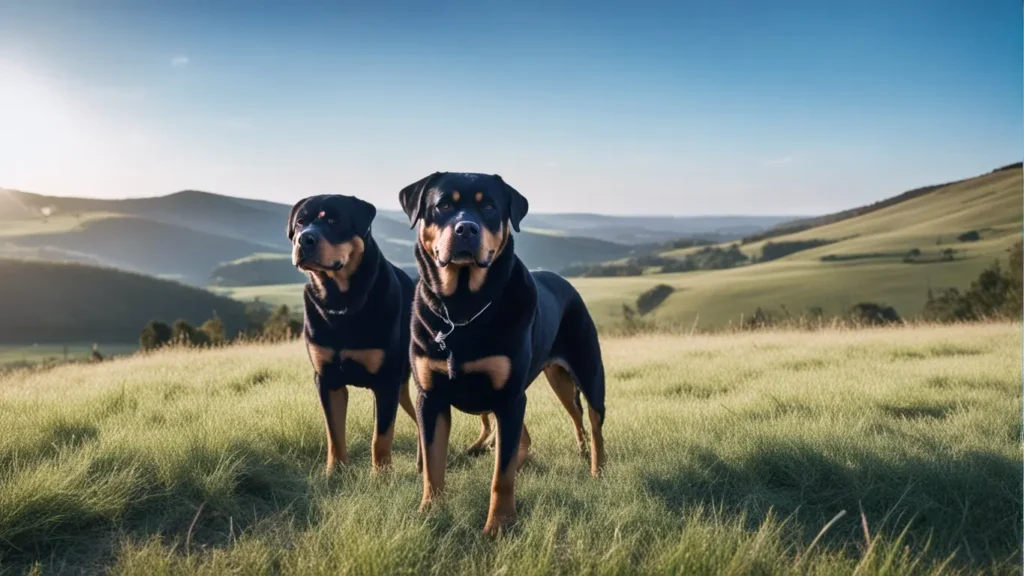
Finding a Rottweiler: Choosing a Reputable Source
Rottweiler puppies can be hard to come by due to the small number of responsible breeders producing litters. Be prepared for a lengthier search compared to more popular breeds. Avoid supporting irresponsible breeders and puppy mills by ensuring health testing and ethical practices are top priorities.
The safest way to get a Rottweiler puppy is through a reputable show or hobby breeder. Expect to pay $1,500 to $2,500 or more. Rescues are another excellent option offering adult Rottweilers in need of forever homes. Adoption fees typically range from $100 to $300.
Bringing home a Rottweiler is a serious commitment. Their health, training, socialization, and exercise require ample time and financial resources. In return, you gain a gallant guardian like no other who will serve as your faithful friend for life.

The Rottweiler: A Dog for Distinguished Owners
This thorough overview of the Rottweiler reveals a breed of commanding presence yet endearing character. Their storied history as rugged working dogs endures through important roles with police and security forces today. No matter their vocation, Rottweilers have proven themselves steadfast contributors to humanity.
For experienced dog lovers able to provide structure, training, and plenty of activity, the good-natured Rottweiler will eagerly assume duties as a devoted companion and guardian. If you appreciate this breed’s unique qualities, welcome a Rottweiler into your life and discover the rich rewards of this special canine bond. Their loyalty is unmatched, and their service is invaluable.